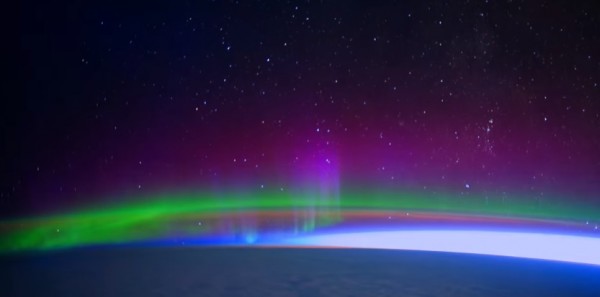By Ana Verayo, | April 21, 2016

NASA TV UHD captures the stunning Aurora Borealis from space in a time lapse video.
NASA just released this new, stunning video, all in glorious 4K ultra high definition, of the majestic Aurora Borealis as seen from space. This video is uploaded on NASA Television on Youtube where the space agency posted unprecedented views of the Aurora Borealis and Aurora Australis, showcasing the spectacular array of lights surrounding the north and south polar regions.
Like Us on Facebook
This footage was captured from the International Space Station, revealing a five minute time lapse of sprawling green lights, eerily glowing as if emanating towards space, washing over the Antarctic night sky over at the southern hemisphere.
Watch the 4K Ultra High Definition time lapse video here.
NASA explains in the video how auroras occur and are produced, which is immediately after the collision of electrons and protons with neutral atoms located in the upper Earth atmosphere. The video shows the skies over Tasmania as it transforms into emerald green shades and deep purple, lighting up the suburban region courtesy of the Aurora Australis.
There are already numerous studies about this phenomena where a recent one reveals that these auroras are now moving down south, away from the polar regions. Scientists from Columbia University say that Earth's magnetic field has been continuously weakening, causing the aurorae to shift towards the south, which is now more visible in Canada and certain parts of the United States.
According to Dennis Kent from Columbia University, the main purpose of the Earth's magnetic field is to protect the planet from solar winds and powerful radiation from space, and the auroras are evidence of this interaction with the magnetosphere.
For those who are nowhere near the polar regions or even in Canada or the U.S., these amazing northern lights which are predicted to move south or not, can be viewed courtesy of NASA's stunning images and videos from space.
These images and videos are taken by the crew aboard the International Space Station, where British astronaut Tim Peake shared his photos of the Aurora Borealis last February, as the orbiting space lab passed through an array of dancing lights across the Pacific Northwest region. NASA astronaut Scott Kelly, who spent almost a year in space, also shared his images of the striking auroras as seen from space.
-
Use of Coronavirus Pandemic Drones Raises Privacy Concerns: Drones Spread Fear, Local Officials Say

-
Coronavirus Hampers The Delivery Of Lockheed Martin F-35 Stealth Fighters For 2020

-
Instagram Speeds Up Plans to Add Account Memorialization Feature Due to COVID-19 Deaths

-
NASA: Perseverance Plans to Bring 'Mars Rock' to Earth in 2031

-
600 Dead And 3,000 In The Hospital as Iranians Believed Drinking High-Concentrations of Alcohol Can Cure The Coronavirus

-
600 Dead And 3,000 In The Hospital as Iranians Believed Drinking High-Concentrations of Alcohol Can Cure The Coronavirus

-
COVID-19: Doctors, Nurses Use Virtual Reality to Learn New Skills in Treating Coronavirus Patients







